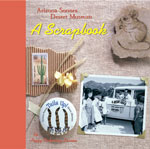
Extended Entries to the ASDM Scrapbook
Lewis Wayne Walker
Lew Walker served as Associate Director of the Desert Museum for seventeen years and exerted a profound effect on its development. Bill Carr described him as "an excellent host, a fine story teller, and one of the best all-round authorities on general natural history ever to work in a museum."
Lew was born on Long Island, New York, in 1906. As a young man he worked for three years as a nature counselor, taxidermist, and exhibit builder for the American Museum of Natural History in New York City. He later moved to San Diego, California, and was employed for six years as Curator of Exhibits at the San Diego Natural History Museum in Balboa Park.
Mr. Walker joined the Marine Corps during World War II, serving in the Pacific. There he authored a survival book for use by U. S. pilots and was a marine instructor in survival skills.
Earlier, while working in New York, Walker was associated with William H. Carr in outdoor nature centers and at the American Museum of Natural History. In 1953 Lew joined Mr. Carr as an employee of the Desert Museum. There, from 1954 through 1970, he helped to design and build exhibits, one of the first being the tunnel, an innovative exhibit at the time. He was also instrumental in designing the circular bird enclosures and open enclosures for the coatis, black bears, and prairie dogs.
Lew established a wildlife, photographic, waterhole blind at the Desert Museum. This attracted not only thirsty animals drawn to water in a dry land, but also photographers from across the country. Their wonderful photographs generated publicity for, and interest in the Museum, as well as greater understanding of desert animals.
Walker was a renowned author and photographer of the natural world, publishing more than 2000 self-illustrated articles, including those in National Geographic, Natural History, and Life. He was a contributor to Natural History of the Southwest and author of Survival Under the Sun. For many years he wrote a weekly column on desert plants and animals for the Desert Museum which was published in the Tucson Citizen.
In the early 1950's, before coming to work at the Desert Museum, Mr. Walker was noted for his attempts to capture a pair of California condors for breeding at the San Diego Zoo. At the time of his attempts there were no breeding pairs of this extremely endangered species in captivity. Although his capture attempts failed, Lew was successful in raising public concern over the fate of this species. Today these birds are being raised in captivity with a limited reintroduction of the birds into the wild.
Lew was instrumental, while at the Museum, in early efforts to save the Masked Bob White Quail, and was a charter member of the Whooping Crane Conservation Association, which was formed at a meeting held in his home at the Desert Museum. During the seventeen years he was employed at the Museum, Mr. and Mrs. Walker lived in the house on the Museum grounds.
For forty years Mr. Walker explored, photographed, and wrote about Baja California and the islands in the Gulf of California. He led numerous trips to the Gulf for various institutions, biologists, filmmakers, and for friends of the Desert Museum. Lew was an enthusiastic ornithologist and combined his interest in birds, the Gulf islands, and conservation in seeking protection for the extraordinary population of birds that nest on Raza Island. His efforts, backed by the Desert Museum, were successful and the Mexican government established the Isla Raza Wildlife Sanctuary.
Mr. Walker retired from the Desert Museum December 31, 1970, and he and Melanie moved to Julian, California. In February of that year his book Survival Under the Sun was published and he was under contract as a consultant for conservation and exhibits at San Diego Zoo's San Pasqual Wild Animal Park. He suffered a severe heart attack and died June 4, 1971.
Melanie Walker, Lew's wife, stated after his death that Lew's proudest achievement was the role he played in the creation of the Isla Raza sanctuary. William H. Carr said of Walker, "Lew's successful efforts to interest people in the establishment of the Republic of Mexico's first bird sanctuary on the island of Raza in the Gulf of California, will always remain as a leading accomplishment in the field of wildlife conservation."
From a plane piloted by a friend of the Arizona-Sonora Desert Museum, Lew Walker's ashes were scattered over the wildlife sanctuary he was instrumental in establishing on Isla Raza.